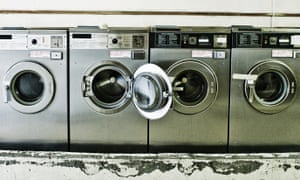What is the Laundromat?
The
Laundromat is a name given by the
Organized Crime and Corruption Reporting Project
to a vast money-laundering scheme. Between autumn 2010 and spring 2014
Russian officials and insiders moved billions of dollars into Europe,
the US and other countries. Law enforcement officers in Moldova and
Latvia have tracked down at least $20bn in dirty money. They believe the
real total may be as high as $80bn. Not all of those involved in the
Laundromat have been identified.
What is money laundering?
A process where you take money gained from crime and clean it so that
it appears to have come from a legitimate source. Typically this
involves multiple transactions.
How did the Laundromat work?
The scheme was ingenious. In many cases, it involved fictitious
companies. Most were registered in London at Companies House. Typically,
company A “loaned” a large sum of money to company B. Other businesses
in
Russia
– fronted by Moldovans – would then guarantee these “loans”. Company B
would fail to return the “money”. Moldovan judges would authenticate the
“debt”, allowing Russian companies to transfer real money to a bank in
Moldova. From here, the cash went to a bank in Latvia, inside the EU.
Who else was involved?
At least 19 Russian banks. One of them was the Russian Land Bank
(RZB). It laundered $9.7bn. From accounts in Russia, money was sent to
other accounts at Moldindconbank in Moldova. From there it was
transferred to Trasta Komercbanka, in Latvia’s capital, Riga. In
Moldova, 15 judges are awaiting trial, together with
10 senior bank managers, central bank officials and four bailiffs.
All face money-laundering charges. Ukrainians and Moldovans appear in
the scheme too, typically as “directors” of fake UK companies. Most had
no clue they were frontmen for a major international scam.
Where did the money go?
Everywhere. The $20bn went via the global financial system to 96
countries. That includes bigger nations such as the US, UK, Germany,
France and China, and smaller ones like Slovenia and Taiwan. The money
flowed through 21 hub companies, with names such as
Seabon and
Valemont Properties Ltd.
The majority were registered in the UK and made brief annual records.
Some were based in Cyprus, an EU island with Moscow ties. Their owners
or beneficiaries are hidden behind a network of shadowy offshore
administrators.
What about the UK?
The total sent to UK bank accounts was $738.1m. Records obtained by the
OCCRP show
how some of it was spent: on furs, diamonds, designer chandeliers, and
fees at one of Britain’s top private schools. It was used to book rock
bands to play in Russia, including
a long-haired outfit from Florida.
It went on home cinema equipment, and expensive wallpaper. Some of the
money flowed into London real estate, including a pub in Bloomsbury and a
townhouse in Kensington. All major British banks processed money that
had already been laundered. The government-owned Royal Bank of Scotland
processed $113.1m, and HSBC $545.3m.
And the US?
More than $63m went to the US. Leading American banks were involved,
including Citibank and Bank of America. The cash went on aesthetic
dentistry, consulting, luxury diving watches and other items. The only
banks that raised money-laundering concerns were American ones. The
Bank of New York Mellon rejected payments.
Who benefited from the Laundromat?
The Laundromat functioned as a giant shadow banking system. At the
top were a number of users and super-users, all impeccably connected to
the Russian elite. Some Russian businessmen importing goods into Russia
used the scheme unwittingly. They hired third-party logistics companies
to deal with Russian customs. These freight forwarding firms made heavy
use of the Laundromat. There are suspicions that well-connected
bureaucrats took a cut.
Has anyone been arrested?
Yes. The alleged architect of the scheme is a Moldovan businessman,
Vyacheslav Platon
– a former MP and Moldindconbank shareholder. Ukrainian police arrested
him in 2016 and extradited him to Moldova to face fraud and
money-laundering charges. Platon calls the accusations “drivel”. He says
there is no evidence of a “predicate crime”: that the money sent from
Russia was stolen. Platon is a Russian and Moldovan citizen. He blames
his arrest on others. Meanwhile, banks including RZB and Baltica in
Russia and Trasta Komercbanka in Latvia have been shut down for money
laundering. The Laundromat firms were dissolved in 2015-16.
Who is investigating?
Moldova, Latvia and possibly Russia. Investigators have spent months
assembling bank records and chasing down complex money trails. In 2014
two officers from Russia’s FSB spy agency visited detectives in Moldova.
They took away records. It is unclear if this was a genuine
investigation or an attempt to discover how much the Moldovans knew.
Probably the latter. This month Moldova said its diplomats
were being “treated abusively” whenever they entered Russia.
Moldova linked this harassment by Russian security services to its
ongoing Laundromat investigation. It said Russian law enforcement was
“totally uncooperative”.

No comments:
Post a Comment